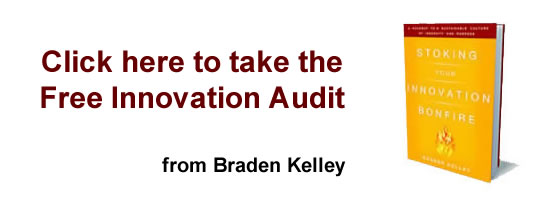Innovation Isn’t About What You Know, But What You Don’t

When Steve Jobs first came up with the idea for the iPod, it wasn’t actually a machine he had in mind, but “a thousand songs in my pocket.†It was, at the time, an impossible idea, because hard drives of that capacity and size just didn’t exist. In fairly short order though, the technology caught up to the vision.
That kind of singular focus and drive helps explain Jobs’ incredible success, but what about his failures?  The Lisa, a precursor to the Macintosh, flopped. So did his first venture after Apple, NeXT Computer. Even at the height of Apple’s dominance, there were missteps such as iAds. Apple TV still hasn’t really gained traction.
“It’s not what you don’t know that kills you,†Mark Twain famously said, “it’s what you know for sure that ain’t true†and that’s the real innovator’s dilemma. Innovation, necessarily, is about the future, but all we can really know is about the past and some of the present. It’s always a balancing act of staying true to your vision and re-examining your assumptions.
The Hazy Technological Future
The reason that Steve Jobs was able to execute his vision of a thousand songs that could fit in a pocket was that it depended on very predictable technology. Memory chips had been improving at a steady pace for decades. So although the specifications he required were not available at the time, it didn’t take a genius to see that would change in short order.
Now consider the situation D-Wave Systems finds itself in. Founded in the late 90s, it bet big on a form of computing called quantum annealing, a kind of shortcut to a general purpose quantum computer. The assumption was that it could produce a useful quantum computer decades before the competition. It only partly turned out as planned.
D-Wave built its first machine back in 2007 and has steadily improved on the initial design. Its latest version is potentially thousands of times more powerful than the 2007 model, yet general purpose quantum computers are moving much faster than anyone anticipated. IBM and Google, as well as others, may have commercial machines available soon.
D-Wave is an extreme case, — because quantum computing is an extreme technology — but everybody faces essentially the same problem. Innovation is always about the future and the future, especially with regard to technology, is often uncertain. D-Wave still has more than a decade head start over its quantum rivals, but that’s not as much as it thought it would have.
The Inscrutable Customer
Lean startup guru Steve Blank likes to say that “no business plan survives first contact with a customer.†It’s one of those quotes that’s constantly repeated because it’s so obviously true to anyone who has ever launched a product. We can analyze surveys till we’re blue in the face, but we really don’t know what will happen until we see something hit the market.
A particularly striking example of this is the I-Corps program that Blank helped develop at the National Science Foundation. The basic idea is to help scientists commercialize their discoveries. It has been enormously successful and has since spread to other government agencies, such as the National Institutes of Health.
On the first day of boot camp the researchers present their idea for bringing their work to market. This is something they think long and hard about, so they’re usually pretty confident going in. Invariably, they get a rude awakening when they realize that, for all of the work that went into building a strategy, they never actually talked to any customers.
What follows are furiously paced weeks in which they interview dozens of customers and find out, much to their surprise, that their idea is a nonstarter. It’s a bit humiliating, but as they continue talking to people, they usually find a more promising application in an industry that had never occurred to them.
The Competition
Henry Ford’s famous quote, “Any customer can have a car painted any color that he wants so long as it is black,†is often mischaracterized. Many take it to mean that he didn’t care about his customers, but the truth is that he wanted to optimize efficiency so that he could make his car cheap enough for “the great multitudes.â€
The famous quote comes from a meeting with salespeople in 1909 and the strategy it represented was, of course, extremely successful. However, when Alfred P. Sloan took over General Motors in 1923, he saw that it created an opening for a company that built cars for “every purse and purpose.†GM surpassed Ford in sales by the end of the decade.
The scrap heap is piled high with products based on good technology that delighted customers, but were outmaneuvered by competitors. Sony’s Betamax was considered to be a better product than the competing VHS standard, but it was outmaneuvered by JVC’s go-to-market strategy. Dell’s direct sales strategy undercut many of the computer giants of its day. The list goes on.
The truth is that every successful strategy involves choices and those choices create vulnerabilities that our competitors will pounce on. That’s just a simple fact of life.
Maintaining The Vision And Pivoting On The Strategy
If you went to an investor and said you wanted to start a business but did not have any idea about the technology, the customer or the competitive environment, you probably wouldn’t get very far. Nevertheless, that’s exactly how every business starts. You have some assumptions, many of which will be proven wrong and you will have to adapt.
One of my favorite stories that I came across while I was researching my book, Mapping Innovation, was that of Elance. It started out as a matchmaker between firms and freelancers. It failed. Then it pivoted to become a pioneer in vendor management software and had some success. It sold that business and went back to the original idea, but incorporated what it had learned about vendor management and hit upon a viable model.
Still, the work was not done. It found that as companies and freelancers began to use its service, new needs arose, such as training, certification and private talent clouds. oDesk became as a strong competitor and the two companies slugged it out for years until they merged to form Upwork. None of this was foreseeable at the beginning.
Unfortunately, an idea can never be validated backwards, only forwards, so we have no real way of knowing what’s viable until we actually give it a shot. That’s why the ones that succeed learn how to test new ideas, see what happens and learn until they find something that really works. Innovation is never about what you know, but what you don’t.
An earlier version of this article first appeared in Inc.com
Wait! Before you go…
Choose how you want the latest innovation content delivered to you:
- Daily — RSS Feed — Email — Twitter — Facebook — Linkedin Today
- Weekly — Email Newsletter — Free Magazine — Linkedin Group
 Greg Satell is a popular author, speaker, and innovation adviser who has managed market-leading businesses and overseen the development of dozens of pathbreaking products. Follow Greg on Twitter @DigitalTonto. His first book, Mapping Innovation, was selected as one of the best business books of 2017 by 800-CEO-READ.
Greg Satell is a popular author, speaker, and innovation adviser who has managed market-leading businesses and overseen the development of dozens of pathbreaking products. Follow Greg on Twitter @DigitalTonto. His first book, Mapping Innovation, was selected as one of the best business books of 2017 by 800-CEO-READ.
NEVER MISS ANOTHER NEWSLETTER!
LATEST BLOGS
Three things you didn’t know about credit cards
Photo by Ales Nesetril on Unsplash Many of us use credit cards regularly. From using them for everyday purchases to…
Read MoreFive CV skills of a business-minded individual
Photo by Scott Graham on Unsplash The skills listed on a CV help employers quickly understand your suitability for a…
Read More


